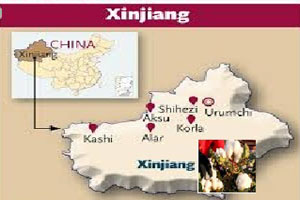
Xinjiang plans 20 bn yuan fund to support textile industry
YarnsandFibers News Bureau 2014-07-20 14:00:00 – BeijingChina's Xinjiang Uygur Autonomous Region prime cotton-growing area, which produces about 60 percent of China's cotton on less than 40 percent of the country's cotton-growing land, aims to create 1 million jobs in the textile industry within the next decade. To support its textile industry has decided to pump 20 billion yuan (about 3.2 billion U.S. dollars) fund.
A fund worth 20 billion yuan will be set up to build textile industrial parks, upgrade technology and provide subsidies for textile enterprises. The central government will contribute part of the fund and Xinjiang will raise the rest.
Yan Qin, deputy secretary-general of the Xinjiang regional government, a press conference in Beijing said that the push for textile development will create more jobs, incomes and maintain social stability in the sector.
Apart from funding textile industrial parks and clothing factories, Xinjiang will subsidize local cotton and electricity in qualified textile industrial parks. The region will adopt strict environmental protection standards and control energy consumption during the process.
According to a 10-year textile development plan, 420,000 jobs will be created with an industrial output of about 86 billion yuan by 2018 and 1 million jobs and 212.5 billion yuan of output by 2023.
The fund will favor southern areas of Xinjiang. Clothing and tapestry factories will enjoy free or low rents for a designated period. Also a language and vocational training centers will open in southern Xinjiang.
In northwest China and home to more than 22 million people of 47 ethnicities, Xinjiang now produces about 60 percent of the China's raw cotton, but most textile companies are in eastern coastal areas far from Xinjiang.
The lack of factories has meant low demand from local enterprises. With poor rail links to the rest of the country, Xinjiang's cotton farmers have felt the pinch in recent years.
Furthermore, China keeps a tight grip on cotton imports to protect farmers, driving domestic cotton prices much higher than imports. In April, the government announced temporary suspension of cotton purchases after national cotton reserves reached 12 million tonnes, an amount that could meet domestic demand for the next two or three years if domestic consumption remains at the current level.
According to Gao Yong, vice president of China National Textile and Apparel Council, the abundant energy resources in Xinjiang will help enterprises integrate their industrial chain and tap new markets and that more textile companies will open production lines there and use more local cotton to reduce costs.
Xinjiang will give special support to projects related to cotton textiles, printing, dyeing and finishing, hand-crafted carpets and knitting, the local government said.
In 2013, the output of Xinjiang's textile industry hit 212.5 billion yuan.
Market Intelligence
Ask for free sample Report

experience
Customer Base
dedicated team
Countries Served Worldwide









